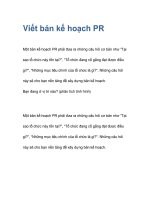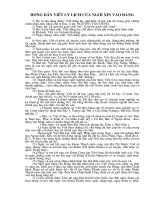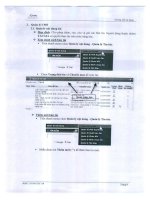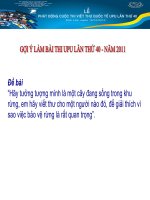08 huong dan viet bai writing task 1 dang process
Bạn đang xem bản rút gọn của tài liệu. Xem và tải ngay bản đầy đủ của tài liệu tại đây (2.56 MB, 28 trang )
LỜI MỞ ĐẦU
Etrain English Center chào các bạn sĩ tử ôn thi IELTS.
Nhận thấy rằng dạng Process trong IELTS Writing task 1 đang là một cản trở với
nhiều bạn trên chặng đường ôn thi IELTS, thậm chí nhiều bạn còn mang tâm lý “sợ”
khi gặp dạng đề này nên Etrain quyết định chia sẻ những bí quyết để làm dạng Process
và làm cho các bạn yêu thích dạng đề này hơn.
Với bản ebook nhỏ này, Etrain thân gửi các bạn các kiến thức thiết thực nhất về dạng
Proces, các ví dụ minh họa và cả các bài tập cùng đáp án gợi ý để các bạn tham khảo.
Tuy tài liệu được viết bằng tiếng Anh nhưng sử dụng từ ngữ đơn giản, dễ đọc để bất
cứ ai đang ôn thi IELTS đều có thể hiểu kiến thức này một cách toàn diện nhất.
Sản phẩm được chia sẻ hoàn toàn 100% MIỄN PHÍ, vậy nên chúng mình rất mong
nhận được sự cổ vũ của các bạn trên chặng đường chia sẻ kiến thức này. Đừng quên
bỏ 1-2 giây comment CẢM ƠN hay LIKE, SHARE bài chia sẻ của Etrain để tiếp
thêm động lực cho chúng mình và cũng giúp kiến thức được lan truyền sâu, rộng hơn.
Để cập nhật những bài chia sẻ VÔ GIÁ sau, bạn hãy follow các trang như sau:
Fanpage: />Website: />Facebook cá nhân: />Youtube: />Etrain mong nhận được sử ủng hộ của các bạn.
Chúc các bạn học tốt!
Etrain English Center
ETRAIN ENGLISH CENTER [ETRAIN.EDU.VN]
1
TABLE OF CONTENT
Basic information about process ................................................................................. 4
Essential steps to describe a process ........................................................................... 6
Exercise 1 ................................................................................................................ 6
Man-made process ..................................................................................................... 9
Exercise 2 .............................................................................................................. 13
Exercise 3 .............................................................................................................. 13
Natural process ........................................................................................................ 15
Exercise 4 .............................................................................................................. 20
Exercise 5 .............................................................................................................. 20
ASWER........................................................................................................................ 22
ETRAIN ENGLISH CENTER [ETRAIN.EDU.VN]
2
IELTS WRITNG TASK 1- PROCESS
ETRAIN ENGLISH CENTER [ETRAIN.EDU.VN]
3
I. Basic information about process
• About the process
1. Without figurative information
2. Not as common as charts and graphs
3. Easier to answer
• Two main types:
1. Man-made process: how coffee, tea, beer or wine are made; how cement or
bricks are produced
Example: The diagram below shows how tomato ketchup is made.
ETRAIN ENGLISH CENTER [ETRAIN.EDU.VN]
4
2. Natural process: the life cycle of a butterfly or frog; the water cycle or how
cows produce milk
Example: The picture below shows the cycle of the frog.
• Present simple
• Voice:
1. Man-made process: Passive voice
2. Natural process: Active voice
ETRAIN ENGLISH CENTER [ETRAIN.EDU.VN]
5
II. Essential steps to describe a process
Step #1: Understand the process
1. Is this a man-made or natural process?
2. What is the result of the process?
3. Where does the process start and where does it end?
4. Is it cyclical or linear?
5. What does each stage of the process do?
6. Are there any materials that need to be added to the process?
7. What are the relationships between these stages?
Exercise 1
Look at the processes in the box and decide which is in man-made process or
natural process.
ARE THESE PROCESSES NATURAL OR MAN-MADE
1.The production of steel.
man-made
natural
2.The lifecycle of a fish.
man-made
natural
3.How a telephone works.
man-made
natural
4.The production of cement.
man-made
natural
ETRAIN ENGLISH CENTER [ETRAIN.EDU.VN]
6
5.The water cycle.
man-made
natural
6. The formation of a planet
man-made
natural
7.The production of coffee.
man-made
natural
8.The lifecycle of the frog.
man-made
natural
9.The process of photosynthesis.
man-made
natural
10.How the internet works.
man-made
natural
Step #2: Write an Introduction
• One sentence
• Paraphrase the general information
Step #3: Write an Overview
• How many stages are there?
• Where does it start and where does it end?
Step #4: Write body paragraphs
• Describe each stage of the process
• You can:
a. Say what each stage does
ETRAIN ENGLISH CENTER [ETRAIN.EDU.VN]
7
b. What it produces
c. If any materials are added
d. And/or discuss the relationship with the previous or subsequent stages
• Describe each step in a sentence or combine the description of some steps into
one sentence.
• About 5 sentences in both two body paragraphs
Each sentence:
Sequencing
1. Firstly, initially, the
Object(s)
-
process begins with ...
2. Secondly, at the second
step
3. After that, following
Given on the
-
diagram
-
Most words
Other
What it does?
-
cannot be
information
Given on the
-
Machine
diagram
-
Time
Should use your
-
Temperature
own words
-
Purpose
-
Place
-
...
paraphrased
that, next, then,
subsequently
4. Finially, at the final
step, the process ends
when ....
Remember:
•
if there are any technical terms in the diagram, you may use them in your answer
•
if it is a man-made process, we generally use the passive voice
•
if it is a natural process, we generally use the active voice
Step #5: Proof reading
1. Are there any spelling or punctuation mistakes?
2. Are the verbs the correct tense?
3. Does the process I describe make sense? Does it match the diagram?
4. Is there any vocabulary repetition we could remove with synonyms?
ETRAIN ENGLISH CENTER [ETRAIN.EDU.VN]
8
5. Do I have 4 clear paragraphs.
6. Did I write over 150 words?
1. Man-made process
Example question: The diagram below shows how tomato ketchup is made.
Step #1: Understand the process
-
Man-made process
-
Linear process
-
Production: tomato ketchup
-
15 steps
Step #2: Write an Introduction
The diagram(s)
show(s)
-
compare(s)
illustrate(s)
the process in which A is/are
produced/made/manufactured
-
the process of producing/making/manufacturing A
-
the A producing/making/ manufacturing process
-
the production/manufacture of A
-
how A is/are produced/made/manufactured
-
how to produce/make/manufacture A
Sample introduction: The diagram shows the process of producing tomato ketchup
Step #3: Write an Overview
Overall,
-
It is clear that
there are .... steps in the process of
-
producing A,
-
the production of A has/includes ...
steps,
starting at (Ving/Noun)
and ending at (Ving/Noun)
-
from (Ving/Noun) to
(Ving/Noun)
Sample overview: Overall, there are fifteen steps in the production of tomato ketchup,
starting at harvesting tomatoes manually and ending at using finished product as a
sauce in some meals.
Step #4: Write body paragraphs
ETRAIN ENGLISH CENTER [ETRAIN.EDU.VN]
9
Sample sentence 1: Describe steps 1 + 2
Initially, ripe tomatoes are picked manually
and put in a basket before being sorted to
separate high-quality from bad ones.
Sample sentence 2: Describe steps 3 + 4
Then, the chosen tomatoes are
dispatched to factories where they are
skinned and its stalk and seeds are
eliminated/removed.
Sample sentence 3: Describe steps 5+6+7
The remaining part is placed into a container for crushing, and then some spices such
as sugar, vinegar and salt are added to the tomato liquid.
ETRAIN ENGLISH CENTER [ETRAIN.EDU.VN]
10
Sample sentence 4: Describe steps 8 + 9
The next two stages are boiling the
container and leaving it for two hours.
Sample sentence 5: Describe steps 10 + 11 + 12
Once the bottles have been filled out, they are then labeled and sent to a quality
controller, where its quality is analyzed.
Sample sentence 6: Describe steps 13 + 14 + 15
Tomato ketchup is packaged into boxes which are after that loaded into lorries and
brought to supermarket, and finally tomato ketchup is eaten with hamburger or fries to
add more flavour.
ETRAIN ENGLISH CENTER [ETRAIN.EDU.VN]
11
Sample essay:
The diagram shows the process of producing tomato ketchup.
Overall, there are fifteen steps in the production of tomato ketchup, starting at
harvesting tomatoes manually and ending at using finished product as a sauce in some
meals.
Initially, ripe tomatoes are picked manually and put in a basket before being sorted to
separate high-quality from bad ones. Then, the chosen tomatoes are dispatched to
factories where they are skinned and its stalk and seeds are eliminated. The remaining
part is placed into a container for crushing, and then some spices such as sugar, vinegar
and salt are added to the tomato liquid. The next two stages are boiling the container
and leaving it for two hours.
Once the bottles have been filled out, they are then labeled and sent to a quality
controller, where its quality is analyzed. Tomato ketchup is packaged into boxes which
are after that loaded into lorries and brought to supermarket, and finally tomato ketchup
is eaten with hamburger or fries to add more flavour.
(167 words)
• Picke (verb): to take flowers, fruit, etc. from the plant or the tree where they are
growing
• Dispatch (verb): to send somebody/something somewhere, especially for a
special purpose
• Skin (verb): to remove the skin of something
• Eliminate (verb): to remove or take away someone or something
• Boil (verb): to reach, or cause something to reach, the temperature at which a
liquidstarts to turn into a gas.
• Package (verb): to wrap goods or put them into containers to be sold or sent
somewhere
ETRAIN ENGLISH CENTER [ETRAIN.EDU.VN]
12
Exercise 2
The diagram below shows the stages used on orange juice production.
Summarise the information by selecting and reporting the main features and make
comparison where relevant.
ETRAIN ENGLISH CENTER [ETRAIN.EDU.VN]
13
Exercise 3
The diagram below shows how the Australian Bureau of Meteorology collects upto-the minute information on the weather in order to produce reliable forecasts.
ETRAIN ENGLISH CENTER [ETRAIN.EDU.VN]
14
2. Natural process
Example question: The picture below shows the cycle of the frog.
Step #1: Understand the process
-
Natural process
-
Cyclical process: Lifecycle of the frog
-
11 steps
Step #2: Write an Introduction
The diagram(s)
show(s)
-
The cycle of B.
The flow chart
illustrate(s)
-
The development/growth of B.
-
The natural process in which B grows.
Sample introduction: The flow chart illustrates the development of a frog.
Step #3: Write an Overview
Overall,
-
It is clear that
there are .... distinct steps/stages in this -
starting at (Ving/Noun)
process,
and ending at (Ving/Noun)
-
the process has/includes ... steps,
-
… distinct stages are shown in this
process
-
from (Ving/Noun) to
(Ving/Noun)
-
begin with (Ving/Noun)
and ending with
(Ving/Noun)
Sample overview: It is clear that there are six distinct stages in this life cycle, from egg
to mature frog.
ETRAIN ENGLISH CENTER [ETRAIN.EDU.VN]
15
Step #4: Write body paragraphs
Sentence sample 1: Describe step 1
Initially, the eggs, which are
called frogspawn, float on the
surface of the pond.
Sentence sample 2: Describe step 2
The step after is the emergence of the
small tadpole, which has a small body
and a long tail.
Sentence sample 3: Describe steps 3+4
Gradually, the tadpole develops and its
body enlarges while the tail becomes
longer.
ETRAIN ENGLISH CENTER [ETRAIN.EDU.VN]
16
Sentence sample 4: Describe steps 5+6
At this point in the cycle, the legs appear in order to prepare the tadpole for its future
life on land and the tadpole is nourished by food stored in its tail.
Sentence sample 5: Describe steps 7+8
Subsequenty, two front legs appear and then the tadpole has a wider mouth, a reduced
tail and bigger legs. At this time, it continues to live in the pond.
Sentence sample 6: Describe step 9
Overtime, the tadpole starts to change into a
young frog and moves onto land. As a result
of being on land, it breathes air and it loses its
tail.
ETRAIN ENGLISH CENTER [ETRAIN.EDU.VN]
17
Sentence sample 7: Describe step 10
Eventually, the young frog become mature.
Sentence sample 8: Describe step 11
The final stage of the cycle is when
the frog finds a mate so as to
produce eggs. Having completed
all these steps, the cycle life begins
again.
ETRAIN ENGLISH CENTER [ETRAIN.EDU.VN]
18
Sample essay:
The flow chart illustrates the development of a frog.
It is clear that there are six distinct stages in this life cycle, from egg to mature frog.
Initially, the eggs, which are called frogspawn, float on the surface of the pond. The
step after is the emergence of the small tadpole, which has a small body and a long tail.
Gradually, the tadpole develops and its body enlarges while the tail becomes longer.
At this point in the cycle, the legs appear in order to prepare the tadpole for its future
life on land and the tadpole is nourished by food stored in its tail.
Subsequently, two front legs appear and then the tadpole has a wider mouth, a reduced
tail and bigger legs. At this time, it continues to live in the pond. Overtime, the tadpole
starts to change into a young frog and moves onto land. As a result of being on land, it
breathes air and it loses its tail. Eventually, the young frog becomes mature. The final
stage of the cycle is when the frog finds a mate so as to produce eggs. Having
completed all these steps, the cycle life begins again.
(196 words)
• Float (verb): to move slowly on water or in the air
• Enlarge (verb): to make something bigger; to become bigger
• Breathe (verb): to take air into your lungs and send it out again through your
nose or mouth
ETRAIN ENGLISH CENTER [ETRAIN.EDU.VN]
19
Exercise 4
The diagram below shows the life cycle of a salmon, from egg to adult fish.
ETRAIN ENGLISH CENTER [ETRAIN.EDU.VN]
20
Exercise 5
The diagram below shows the water cycle, which is the continuous movement of
water on, above and below the surface of the Earth.
ETRAIN ENGLISH CENTER [ETRAIN.EDU.VN]
21
ASWER
Exercise
Exercise
11
1. man-made
6. natural
2. natural
7. man-made
3. man-made
8. natural
4. man-made
9. natural
5. natural
ETRAIN ENGLISH CENTER [ETRAIN.EDU.VN]
10. man-made
22
Exercise
2- Sample
answer:
Exercise
2- Sample
answer
The diagram shows the process in which orange juice is produced.
Overall, there are two different ways to produce orange juice, including eighteen steps
in total. The process starts at delivering fresh oranges and ends at selling finished orange
juice bottles.
Firstly, fresh oranges are picked and delivered by truck to factories where they are
washed and squeezed so as to extract juice. The waste solid becomes food for animals
while the juice is processed in two different ways. The simpler one is that fresh juice
is pasteurized and packaged before being dispatched to shops.
The second way is to produce concentrate juice by shipping this juice in a refrigerator
truck to another factory for water to evaporate. The resulting product is then canned
and transported to a warehouse. At the final stage, this concentrate juice is mixed with
water in a factory and then poured into bottles, ready for sale.
(151 words)
• Pick (verb): to take flowers, fruit, etc. from the plant or the tree
• Deliver (verb): to take goods, letters, etc. to the person or people they have
been sent to; to take somebody somewhere
• Squeeze (verb): to get liquid out of something by pressing or twisting it hard
• Process (verb): to treat raw material, food, etc. in order to change it, preserve it
• Pasteurize (verb): to heat a liquid, especially milk, to a particular temperature
and then cool it, in order to kill harmful bacteria
• Dispatch (verb): to send something somewhere
• Evaporate (verb): to change from liquid into gas
ETRAIN ENGLISH CENTER [ETRAIN.EDU.VN]
23
Exercise
Exercise3-3-Sample
Sampleanswer:
answer
The figure illustrates the process used by the Australian Bureau of Meteorology to
forecast the weather.
There are four stages in the process, beginning with the collection of information
about the weather. This information is then analysed, prepared for presentation, and
finally broadcast to the public.
Looking at the first and second stages of the process, there are three ways of
collecting weather data and three ways of analysing it. Firstly, incoming information
can be received by satellite and presented for analysis as a satellite photo. The same
data can also be passed to a radar station and presented on a radar screen or synoptic
chart. Secondly, incoming information may be collected directly by radar and
analysed on a radar screen or synoptic chart. Finally, drifting buoys also receive data
which can be shown on a synoptic chart.
At the third stage of the process, the weather broadcast is prepared on computers.
Finally, it is delivered to the public on television, on the radio, or as a recorded
telephone announcement.
(IELTS Simon, 170 words)
• Analyse (verb): to examine the nature or structure of something, especially by
separating it into its parts, in order to understand or explain it
• Present (verb): to give, provide, or make something known
• Deliver (verb): to take goods, letters, parcels, ect. To people’s houses or places
of work.
ETRAIN ENGLISH CENTER [ETRAIN.EDU.VN]
24









